Seeing glowing bioluminescence in person is one of those things in nature that just makes you go, wow! Witnessing it in Costa Rica, on a kayak, in the dark, under the starlit sky makes the experience even more special. In this post, we’ll take you along on a bioluminescent kayak tour on the Nicoya Peninsula.

What Is Bioluminescence?
Bioluminescence is when living things give off a natural light or glow. You’ve probably experienced it when seeing fireflies (lightning bugs), but it also can be found in mushrooms, jellyfish, worms, and other creatures. It can be somewhat magical or somewhat creepy (in the case of worms).
Water also can give off a bioluminescent glow, but it is not from the water itself. The light comes from microscopic algae or plankton living near the surface of the water. These organisms only grow and thrive under the right conditions.

Bioluminescent Algae in Costa Rica
While some places in the world only experience the right conditions for bioluminescent algae occasionally, some spots in Costa Rica, like the Gulf of Nicoya, have it very consistently. This is especially true near the town of Paquera, where we took our tour.
This bioluminescent kayak tour is located about a half-hour from the small destination of Tambor on the southern Nicoya Peninsula. It is an hour from Montezuma and about 1.5 hours from Santa Teresa/Mal Pais.
The roads in this area are mostly paved but very curvy, so use caution driving at night.
Our Bioluminescent Kayak Tour Experience
Waiting Until Dark
Our tour began in Punta Cuchillos as the sun was falling. This little point is about ten minutes from the Paquera ferry landing on Costa Rica’s Nicoya Peninsula. Most people get off the Puntarenas to Paquera ferry and drive right past it.
We were guilty of that too, having done it many times. But tonight, we felt like we were in on the secret.
From the main road, we parked and walked down a narrow path to the Bahia Rica base camp.
Here, we were greeted with refreshments and told to just relax until it got a bit darker. Everyone on the tour took in the spectacular sunset over Paquera Bay. As the sun sank, the green mountains of the Nicoya Peninsula grew dark in the background.

An Introduction to Bioluminescence
Our guides, Jose and Luis, soon appeared with smiles and introduced themselves. They gave us a lot of information about bioluminescence and quizzed us a bit on what we already knew.
Luis was quite passionate about the bioluminescence and how each evening was a little different. He was excited for us all to experience it.
Jose added in some practical information about where we would go in the kayaks, how to see the most, and how it would be difficult to photograph the glow from a moving kayak.
Jose also added that they would try to get some photo opportunities throughout the tour, but it was best to just enjoy the experience in person.
Setting Off
Since there were about a dozen of us taking the tour that night, our guides split us into two groups for a more personalized experience. Half of us went along with Jose and the others went with Luis. We were given life jackets and paddles, and before we knew it, were led down to the water’s edge.
There, the kayaks were lined up for us. The guides shined their flashlights while we got in and pushed off from shore. Some couples and friends shared double kayaks, while the rest of us took singles.
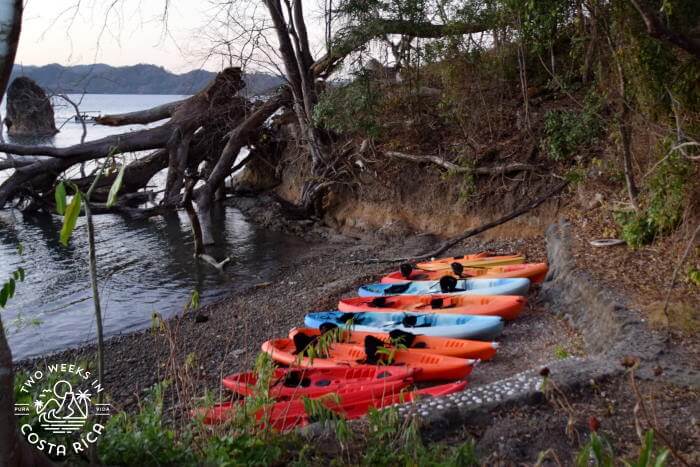
Kayaking in the dark was a different experience. Many of us were already bumping into a half-sunken log and each other before the guides got us organized and paddling forward.
Once we all got the hang of it, though, it was quite relaxing and beautiful. The stars overhead looked amazing in the dark night, and the occasional lights from homes on the shoreline gave us a sense of where we were.
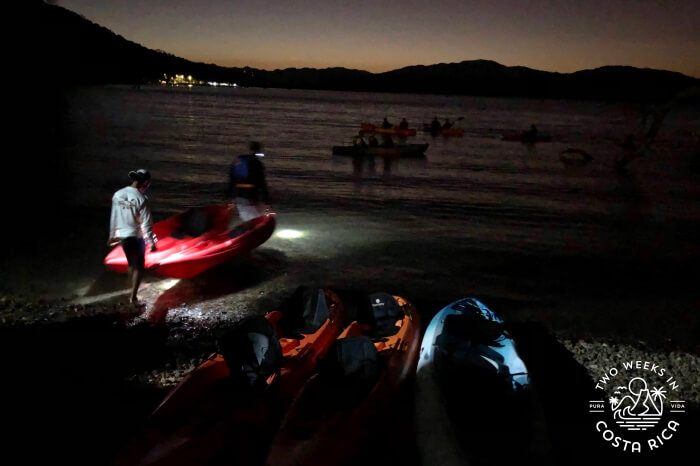
Seeing the Bioluminescence
We weren’t but ten minutes into the tour before Jose asked us to paddle closer to a small rocky island. Here, we found a very calm cove away from the current.
Jose splashed the water with his paddle. We all immediately saw the blue glow! We tried it too while Jose explained that the current and wind gather the algae along rocks and in coves. When these concentrations of algae are disturbed by waves or a splash, they give off the light.
Tour Highlights
While our first experience at the small island was amazing, it got even better. As we rowed past the island, the current from our paddles made swirling blue patterns in the water. The gentle waves made by our kayaks gave a shimmering glow.
We soon approached a shoreline where the concentration of algae was even denser. A tiny splash in the water set off intense sparkles of blue light.
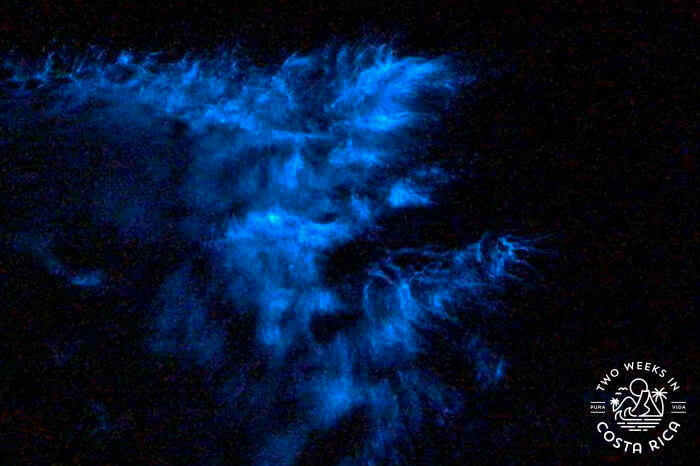
We then saw a school of fish darting through the shallow water, leaving streaks like shooting stars.
Jose told us to stop for a minute and touch the water with our hands. As we lifted our hands in and out of the sea, they came up covered with what looked like glowing blue glitter. After a minute, the lights slowly disappeared.
Photographing the Bioluminescence
Before the tour, we had done some research on taking photos of bioluminescence. It seemed that the best way to do this was from shore, using a tripod, and a slow shutter speed. You then need to disturb the water and snap your picture.
From a kayak, of course, this was nearly impossible. We tried the slow shutter speed, but with the constant small movements of the kayak, we could not get a shot. Writing about this experience without getting any pictures was not an option so we needed a backup.
Our cell phone worked a little better but was still very difficult. We got a lot of plain black photos.
What eventually worked with our iPhone was to set it to take live photos. And take a lot of them! Live Photo takes a picture in a short window of time, sort of like a two second video clip. You can then go in and edit which frame you want to keep. You adjust the frame until you find the one which focused on the blue glow.
Though we got a whole reel of black pictures, we did manage to get a few usable ones.
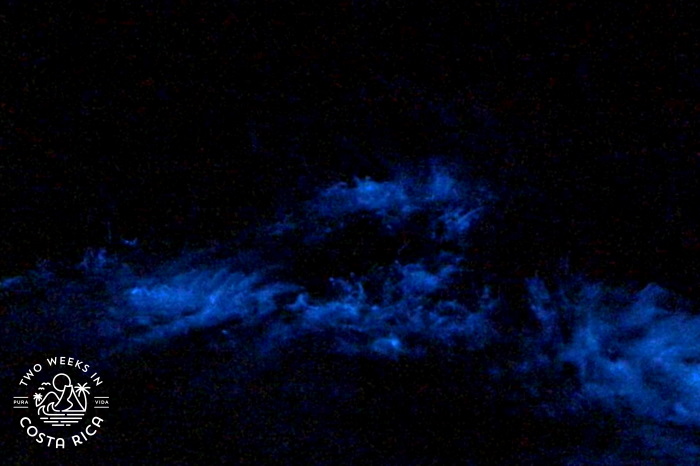
Overall, we’d recommend trying a few photos but just putting the camera or phone away so that you can enjoy the experience and remember it yourself. Once we did that, it was much more fun.
Booking a Bioluminescent Kayak Tour
Tour Company
There are a couple of different bioluminescent kayak tours available in the Paquera area. We were really happy with Bahia Rica and the guides were great.
One other company we met out on the water had a really large and noisy group. We were glad that Bahia Rica broke us into smaller groups for a more enjoyable experience.
Duration and Cost
Tours are around 1.5 hours long and cost about $35.
Full Moon
Keep in mind that around the full moon, it can be difficult to see the bioluminescence. The darker the night sky, the better the experience.
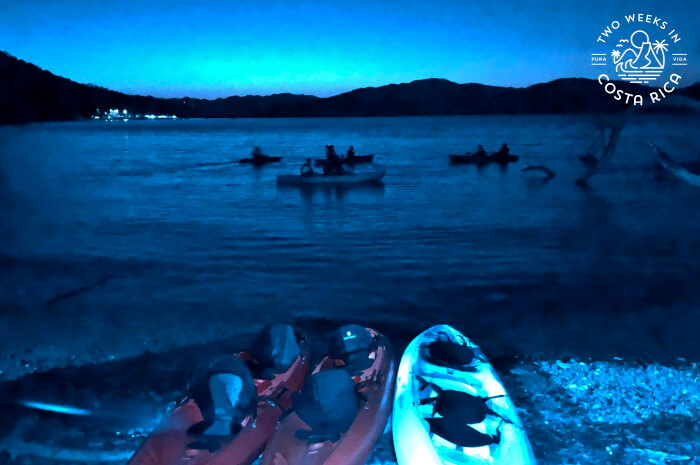
Conclusion
If you’re looking to experience Costa Rica’s bioluminescence for yourself, the Nicoya Peninsula is one of the best spots in the country. We were really surprised by how cool it was to see it in person and hope you get a chance too.
Have a question about the bioluminescent kayak tour? Ask us below.
Looking for more information to help you plan your trip? Check out these posts:
Taking the Puntarenas-Paquera Ferry – If you are heading to the southern Nicoya Peninsula, make sure to read this post to learn about the ferry that cuts across the bay.
Car Rental Discount – This area of the country is best explored with a rental car since attractions and tours are spread out. Get a discount and free extras when booking through our page.
Santa Teresa: Costa Rica’s Trending Beach Town – Santa Teresa has changed a lot recently. Although remote, it has become a hot spot for tourism and digital nomads.


Absolutely loved the Bio tour with Bahia Rica in March 2021. The water lit up with a swish of our hand or paddle. 100% recommend going on the tour!
Ditto! We are a family of 4 adults and we did this tour with Jose and Luis. Excellent, small groups and excellent English. Being so close to the sparkling silvery water – some even got in- was amazing and different to a regular tour. Highly recommended. We went in the basis of the recommendation on this site and weren’t disappointed at all. Thanks all!
Hi Jenn, we are planning a 4 week Costa Rica trip in Jan 23. We have more or less decided to stay in Samara for the Pacific part of the trip, mainly for the possibility of seeing the turtles in the Ostional National Park, but additionally following your description of the town.
I thought we could travel to Paquera from San Jose, stay there, do the tour and then continue to Samara the next day.
The flight we want arrives in San Jose in the evening of Jan 21. The predicted date of the arribada is Jan 25th, so it does look possible to do this.
Please let me know watt you think. We will also need some shuttles, which I would like to book through your website when the I have confirmed our dates.
FYI, we are aged 69 and 63, quite fit for our age. Is the tour suitable for us?
Many thanks.
Please send shuttle info including length of time and price from San Jose to Arenal, from Arenal to Monteverde and Monteverde to Paqueras. Thanks a lot.
Hi Belline, You can use our website to find this information. You can use this link and then put in your pick up and drop off locations. Those shuttle routes are all on there, except for Monteverde to Paquera, which is not common. If you’d like a quote for that, please email us at bookings(at)twoweeksincostarica(dot)com Thanks!
We are staying norsara for 2 nights the beginning of March … I would love to experience this … do you think this is to far for us to travel at night and find our way back to our hotel ? 😂 can u tell me how far Nosara is to the tour?
Hi Lisa, Yes, it’s too far from Nosara, unfortunately. It’s about a 3 hour drive. You would want to stay in Tambor or Montezuma to do the tour.
Hi Jenn and Matt,
We are staying in Samara, do you think this tour is doable for us? Also, is this tour appropriate for our kids, ages 10 and 12?
Thank you!
Hi Gina, Because it’s a night time tour, it’s too far to do from Samara. You would want to do at least an overnight near Paquera.
We were thinking of driving from Manuel Antonio down to see the bioluminescence. If we take the ferry with our car, is it doable to do the whole thing same day, see bio that same night and just stay one night in Paquera and then off to somewhere else? TIA.
Hi Alex, Yes, if you did a morning or mid-day ferry, it would be possible to do only an overnight in Paquera for the tour and not be too rushed.
Hi! Do you think it’s absolutely necessary to do a kayak tour for the bioluminescence? I would prefer seeing it from the beach. Do you know if it’s possible to see near the town of Montezuma? Thanks!!
Hi Karine, From what we understand, Paquera is the best place to see bioluminescence on the Nicoya Peninsula. There is a tour company out of Montezuma but they take people to Paquera for tours. You may be able to do it out of Curu too. Sometimes you can see bioluminescene right from the shore but it depends on conditions.
How close to the new moon did you take the tour? I’m wondering if it would still be spectacular 5-6 days after the new moon?
Hi Melissa, It’s based on the full moon. The tour company we reference in our article has a calendar on their website that shows the full moon and when to avoid tours.